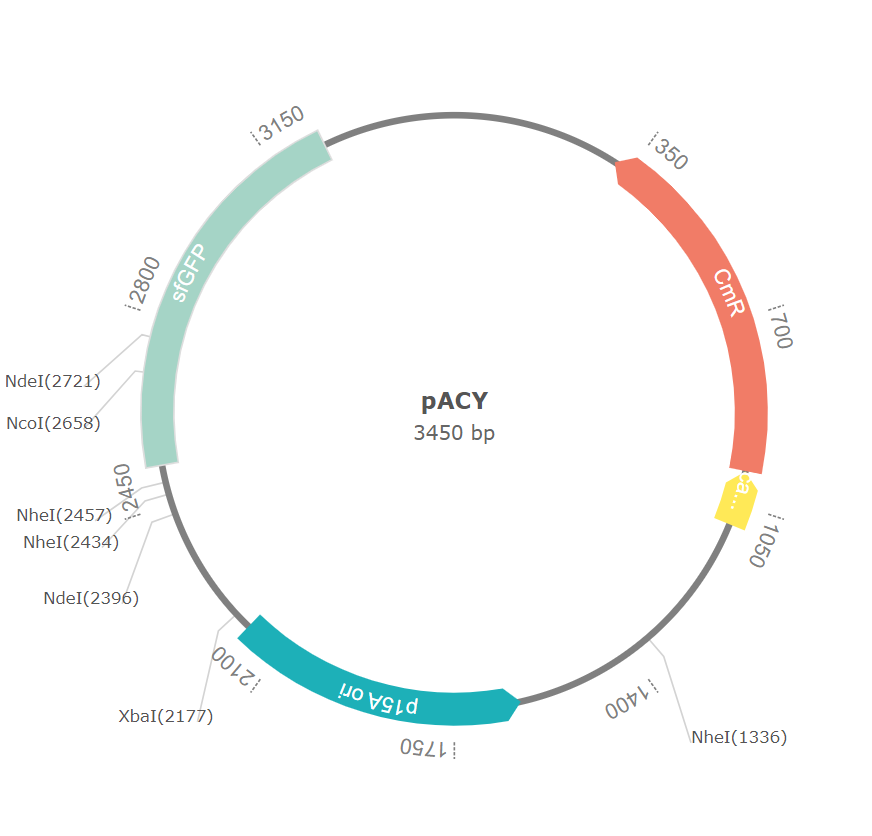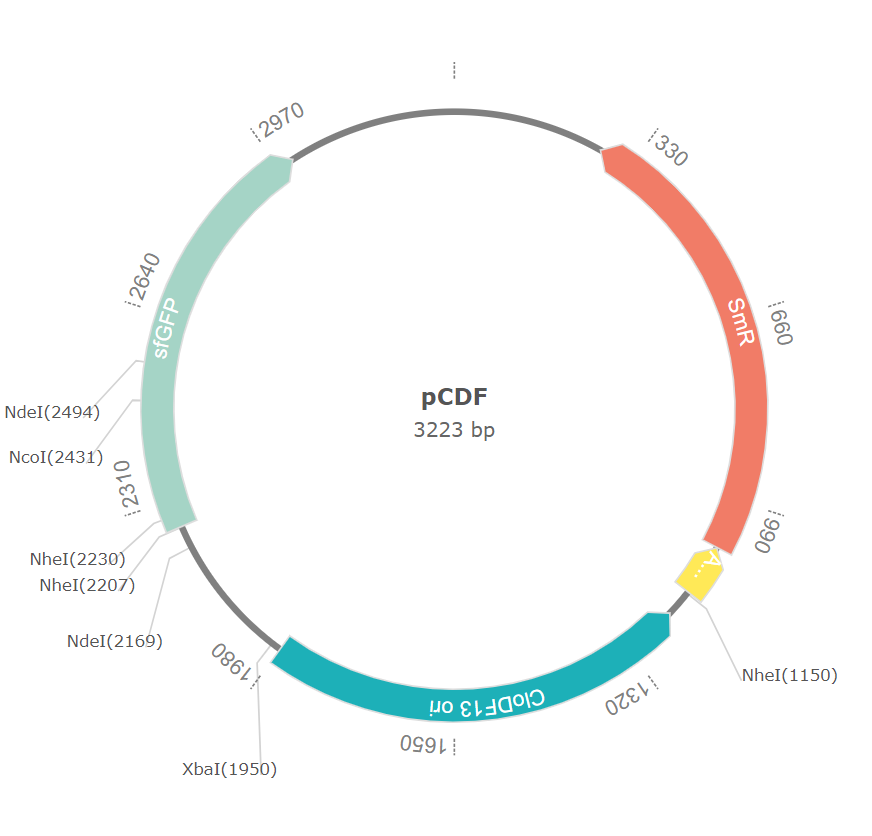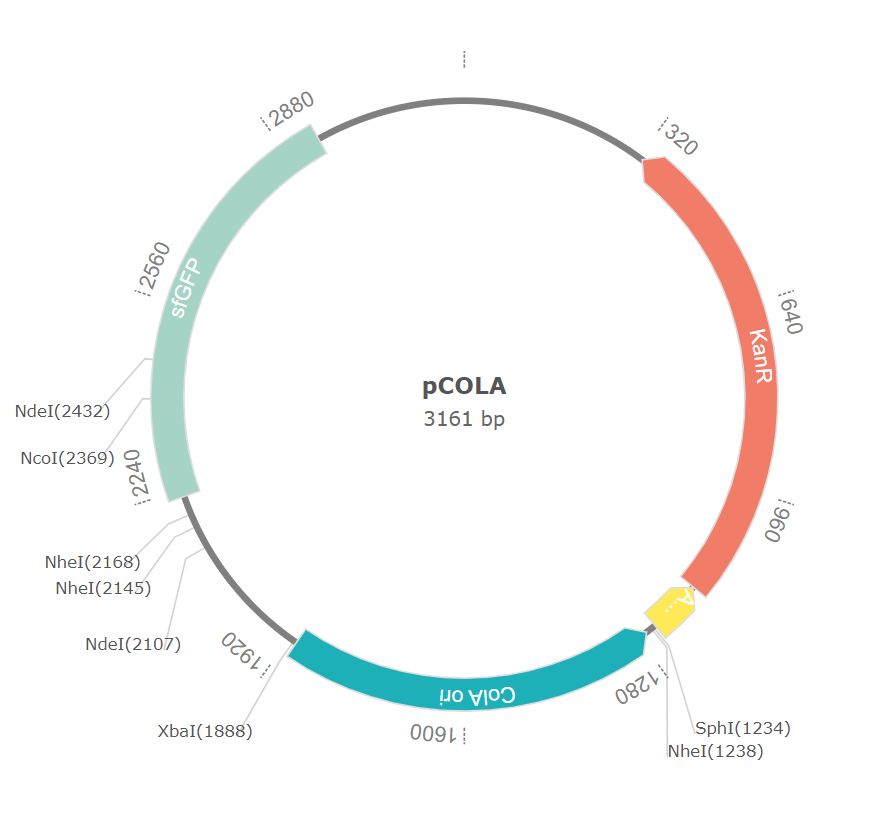Materials and methods |
Part selection - Inserts
|
We chose three constructs from our Parts Collection to demonstrate a straightforward linear transduction genetic communication pathway. For the Input we selected the dpB.003 (Bba_K4216027) construct for its induction through the redox pyocyanin inducer. For the Processor we selected the dpB.011 (Bba_K4216036) for its induction through the input construct and OCH14 chemical inducer. And finally, we selected the dpB. 013 (Bba_K4216038) for its induction through the Processor construct and the OC6 chemical inducer. |
Plasmids Selection
|
The plasmid used in the toolkit are built from the cloning of a set of commercial backbone vectors named
pDuet. pCOLA, pACY, pCDF pDuet vectors were selected for our toolkit project. These vectors can be used in combination to coexpress 2 proteins or
more. The aim is to determine which pDuet within the
selection of three will be a better fit in each component - i.e
pDuet 1 functions better as an input and enables an overall clearer output signal
than pDuet 2.
|
Cloning
|
Each of the input, processor and output inserts selected prior have been cloning using cloning gate technique into all three of the pDuet vectors. We built 9 different combinations of pDuets and transformed them into a DH5alpha strain of E.coli. pCOLA has an antibiotic resistance cassette to chloramphenicol ; pACY for spectinomycin and pCDF for Kanamycin. Each of the vectors have a different antibiotic resistance and are plated accordingly on LB agar for growth. Following successful incubation, each transformant is PCR amplified, analysed via gel electrophoresis, miniprepped to extract the purified plasmid and sequenced. |
Tri-plasmid transformation
Determination of the genetic circuit viability necessitates the transformation of all combinations of three plasmids (input, processor and output) into E.coli. Here are the combinations.
| Transformant number | Input | Processor | Output |
|---|---|---|---|
| 1 | pACY - dp003 | pCOLA- dp011 | pCDF- dp013 |
| 2 | pACY- dp003 | pCDF- dp011 | pCOLA- dp013 |
| 3 | pCOLA- dp003 | pCDF- dp011 | pACY- dp013 |
| 4 | pCOLA- dp003 | pACY- dp011 | pCDF- dp013 |
| 5 | pCDF- dp003 | pCOLA- dp011 | pACY- dp013 |
| 6 | pCDF- dp003 | pACY- dp011 | pCOLA- dp013 |
Plate reader experiment
|
The transformed cells were incubated overnight in media containing all three antibiotics. These were then inoculated in a 96-well plate with the chemical inducers associated to each component. INPUT -PROCESSOR-OUTPUT TRI PLASMID PLATE READER EXPERIMENT This experiment aims at analysing the induced protein translation by the output part of the general circuitry which is a representation of the viability of the genetic circuit. The output plasmid is contains the cm74 inducible promoter pLux76B. The processor plasmid containing the promoter p57m - which expresses c74m- is itself inducible by CinR. CinR is expressed by the piocynin inducible input plasmid. The protein expressed by the output plasmid is cm99 mscarlet, a red fluorescent protein. This experiment is conducted using a plate reader to analyse all the possible combinations of triple plasmid constructs to be transformed in a single cell. It is important to note that no same vector among the chosen three pduets (pCola, pACY, pCDF) and inserts can be transformed in the same cell. For each combination of plasmids, a control experimentis done. A dose of piocynin at 5 μM is chosen accordance to a study conducted by Meyer, A.J. (2019) and which proves that piocynin at 5 uM is the optimal concentration. This data is always confirm by our input characterisation study ( link to lou's input experiment ) where this dose has been shown to be optimal for the induction of the isolated input signal. Single chemical inducers OHC14 (activates processors device promoter) and OC6 (activates output device promoter ) are also respectively each added to the all the combinations. The optimal dosage chosen for OHC14 is10^-2 μM and the one chosen for OC6 is 10^-3 μM. These values has been chosen in accordance to Meyer, A.J. (2019) and our processor and output characterisation experiments ( ref yves et vincent processor output experiments) which demonstrates that these concentrations as most optimal. |





